Map and information on Laos, Click Here
Entered Laos 31st October.
Exchange Rate: 1USD = 8000 Kip
Fuel: 1 Litre = 4500 Kip
Camping: Difficult, and not necessary.
Pension: – $2 to $4
Road conditions: – The worst ‘roads’ I have ever seen, some good, and yet some of the best riding I have had on this whole trip. Most roads are unsealed.
Speed limits: – Mostly 50km/hr, but Irrelevant.
Border crossings from the west: – Many along the Mekong river, which forms the border to Thailand.
Toll roads near border crossings: – I doubt there will be toll roads here for quite some time.
Food & Drink: – 660ml beer 6-8000Kip, Noodle Soup 4000, Mains about 12000.
Indo-China was under the colonial control of the French until the late 1950’s, when Communism took control. John F. Kennedy vowed to fight communism in Indo China, and eventually led to the US declaring war on Vietnam. Laos and Cambodia were unofficially involved too, even though war was never officially declared on them.
The Viet Cong used Laos to transport supplies to the front lines, and built sophisticated networks of roads and tunnels on the Laos side of the border, called the Ho Chi Minh trail. The transport route was heavily bombed, but with almost no effect. The supply line was rarely cut. The US had major air force bases in Thailand, and whenever a bomber returned without dropping it’s load on Vietnam (usually because of cloud cover) it would drop them on Laos. Later, Laos became a direct target, but the US denied for years that they ever bombed Laos. By the end of the war, Laos had over 10 tonnes of TNT/square km dropped on it, or over half a tonne for every man woman and child. ‘Agent Orange’ defoliant was dropped all along the Ho Chi Minh trail, which doesn’t break down in the environment, and is still killing people today. At the time, the locals had their water supply poisoned by the defoliant, and had no water for drinking of irrigation. If the bombs or poisoning didn’t get them, starvation did. Laos has the unfortunate distinction of being the most bombed country on earth on a per capita basis. The Americans dropped more bombs in this tiny country than they dropped in the whole of WWII.
The French and the US weren’t the only ones to wreak havoc here. The Loa people were pretty good at it themselves. The Communists tried to stop the people practicing Buddhism, and imprisoned intellectuals and political enemies just as Cambodia did, but without as much bloodshed. None the less, a mass exodus from Laos started.
Largely because of their tumultuous past, Laos is now one of the poorest nations on earth. Most of the population is involved in agriculture, and Laos is a very fertile country, so starvation is not a problem. Outside of a few large cities, the country has very little infrastructure such as power, roads, running water, health services etc.
In spite of everything, the Lao people are amongst the friendliest people I have ever met. They have the most wonderful natural smiles, particularly in the far north, which is part of the Golden Triangle heroin production area. The people in general seem to be so happy that it is hard to believe their poverty and recent difficulties. I often wonder who has it right, these poor farmers, or us westerners, but then I only have to remind myself of diseases like malaria, encephalitis, water flukes etc to realise that life is a very tenuous proposition in 3rd world countries.
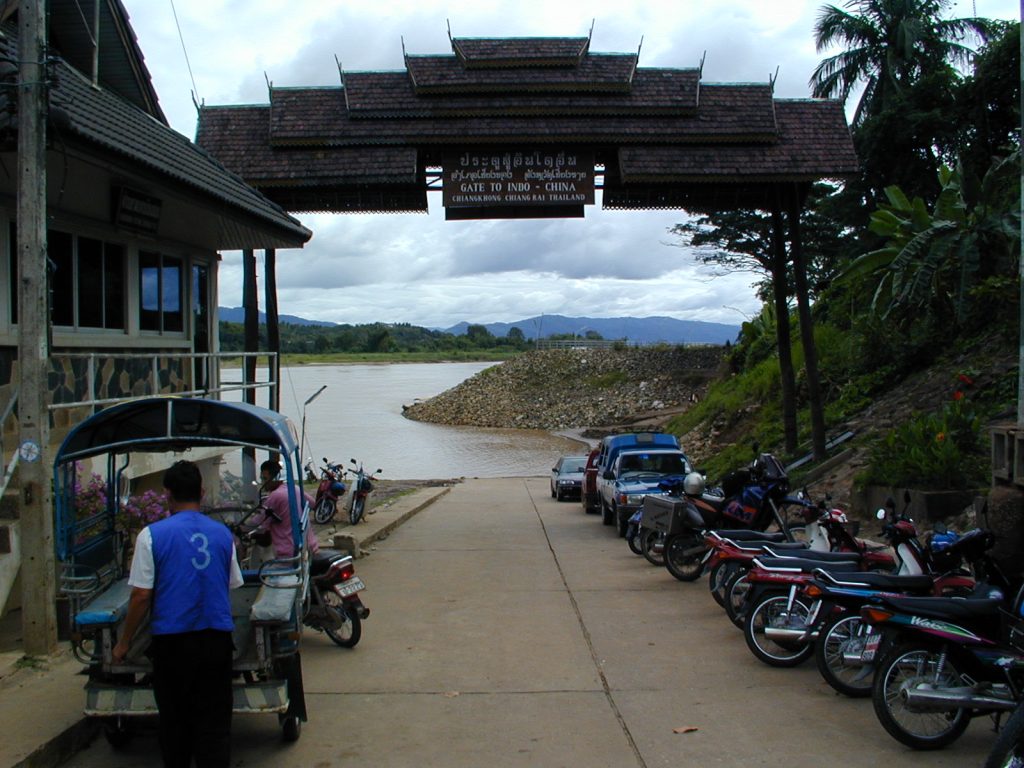
The Golden Triangle, northern Thailand at Chiang Khong. The sign on the arch says welcome to Indo-China. This marks a significant change in living standards for the worse, and poor infrastructure for roads, sanitation, communication, health etc. The whole of Indo-China has seen some terrible wars that have set them back decades. Colonialism has not benefited these countries.
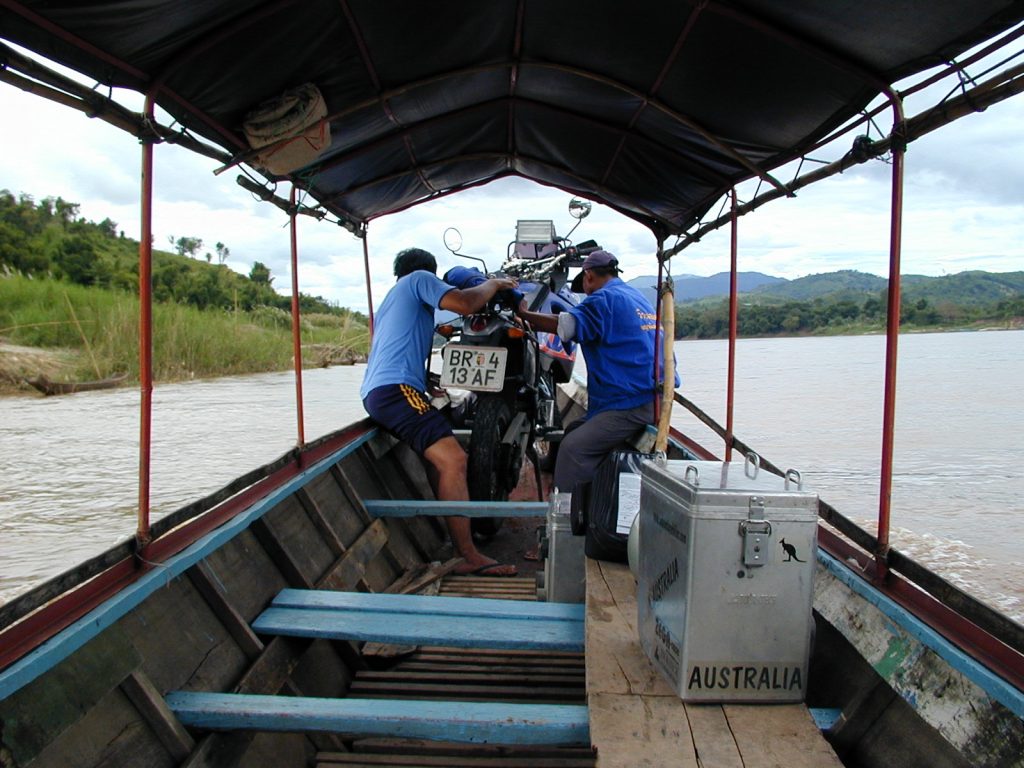
There is a car ferry, but they wouldn’t take me across on my own. I had to hire a long-boat to get across to Laos. The Mekong is about 300m wide here. The boat is more narrow than this picture indicates, and it was getting a fair sway up. The handlers were good though, they keep a firm grip on the bike all the way.
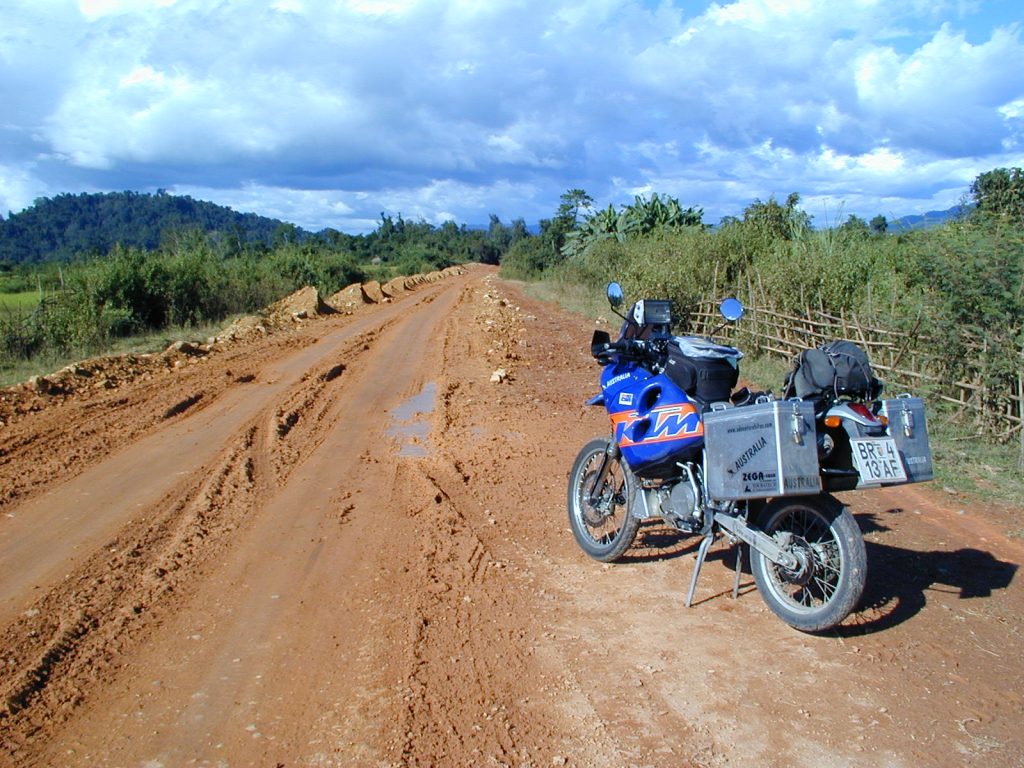
Getting through customs was a breeze. It took all of 15 minutes, and I was on my way by 2:30pm. I had no idea what the road conditions were going to be like, and I fully expected to be in Luang Nam Tha 200km away by night fall. These were the conditions that greeted me. Greasy red mud roads.
I did all of Laos on my own. I had planned to meet the three of the guys I had been travelling with on-and-off there, but none of them made it. They all tried to enter at Chiang Kong, but were daunted by the conditions, and turned back. I was thankful I had a KTM, which revels in these conditions. They had a BMW 1100GS, and two Honda Africa Twins, all very heavy bikes.
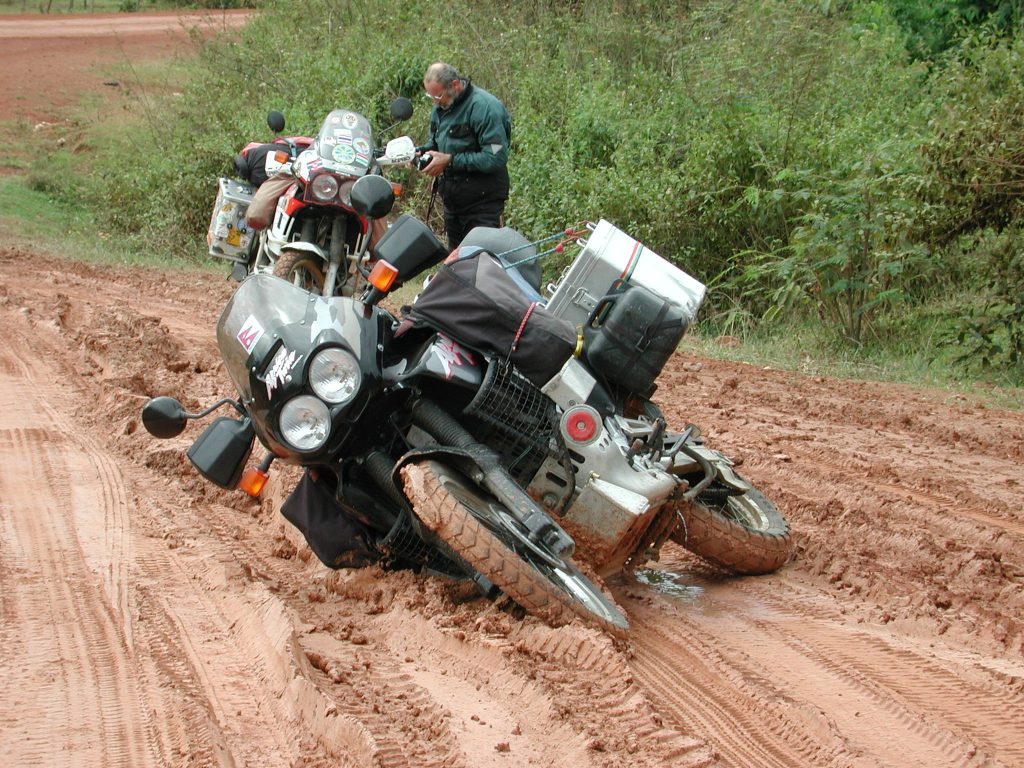
Horsts bike, getting down and getting dirty. Gernot in the background. Photo by Horst

This may give you an idea how slippery the roads are. This truck was coming down a small decent when it lost traction on the rear wheels and slid into a gutter and tipped over, spilling it’s load of coal. These trucks run from a small open cut mine to the river, where it is loaded onto river boats to be shipped down the Mekong.
Most of the population in Laos live somewhere near to the Mekong river. It is the main form of transportation, because the roads are so bad, and impassable in the wet season. I was one of the very few vehicles that were able to get through this northern road. Laos, as well as most of SE Asia had just had the highest rainfall in the last 40 years. I had to negotiate mud, rocks, deep rivers, and it was all in the mountains, which meant going up and down, left and right incessantly, over slippery roads. It is a good way to test your level of concentration, because there just wasn’t any let-up. There were no easy parts to take a rest on. I was actually having a lot of fun, and I considered it a great challenge. I managed to stay upright for the whole distance, despite a few near incidences.
Despite the picture I painted above, it really wasn’t that bad. It was difficult, but negotiable. I have ridden on much worse tracks, but none that claimed to be a road for general traffic. This was Laos’s highway number 13, which is why I was expecting to make Luang Namtha that night. I didn’t get halfway, and late in the afternoon, I was starting to wonder what I had got myself into. There was only local hill tribes along the way. I had left my camping gear in Bangkok because I didn’t expect to need it (in fact I hadn’t used it since Pakistan). I ended up riding in the dark, and at one point had to cross a river. It was a particularly black night, and I couldn’t see how deep it was, but I had just passed a tractor a few kms back, so I waited for him. I watched how deep it was, and his path, then followed. According to my map, I had be close to a village. It seemed to take forever to get there, because I was going so slow in the dark, but finally, relieved, there it was. I stayed with a hill tribe, but they aren’t as primitive as the word ‘tribe’ might indicate. They had a proper (squat) toilet, and my room was made of local timber and bamboo, and they gave me a simple meal of fried eggs and rice, no sauces or flavourings, nothing else. The locals were quite intrigued by my presence. The children looked and giggled, the adults smiled a lot, but weren’t game to try to communicate.
I tried to take a photo of my accommodation, but in the morning, the fog was so thick that everything beyond 5m was a white-out.. We were literally in the clouds, at an elevation of about 1500m from memory.

I thought I was going to be stuck here for some time. This logging truck was bogged to its’ dual driven axles, and there was no way around. We wedged some watermelon sized rocks in between the dual wheels, and after some serious revs, wheel-spin, tyre and diesel smoke, it finally edged out of the quagmire. The wheel ruts are deeper than they look. My panniers were dragging on both sides going through. I had to get off and walk beside the bike to unload the suspension.
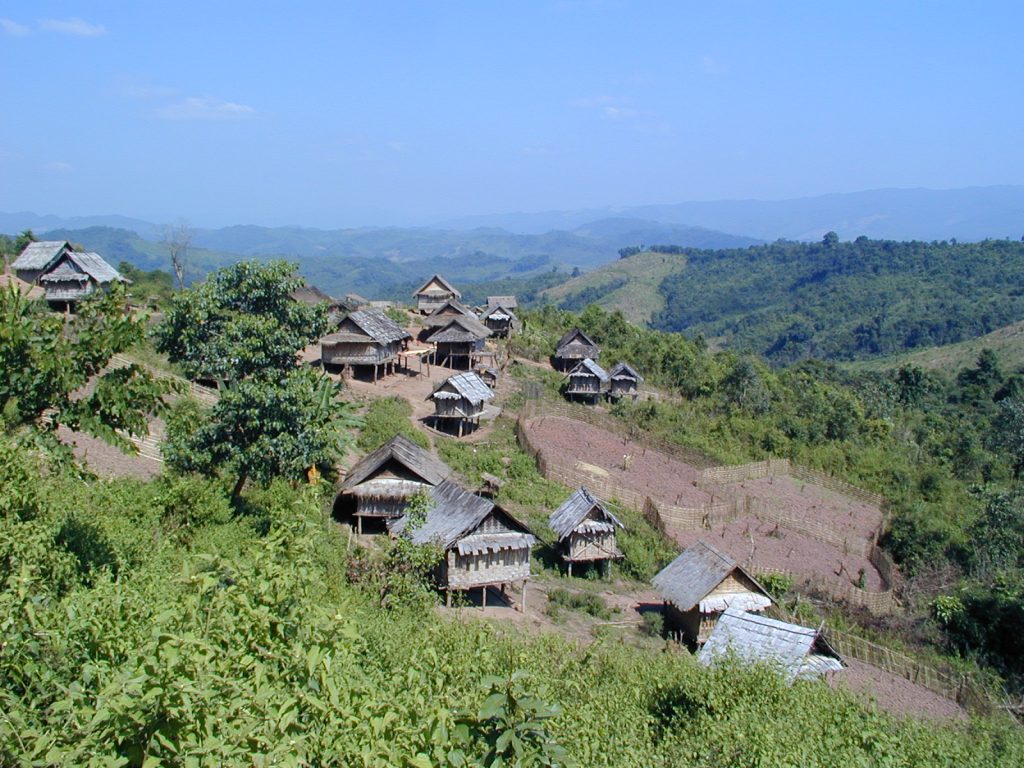
A view of a hill tribe village. This is part of ‘The Golden Triangle’, but there are serious government and foreign aid groups working to eradicate opium production. I saw posters aimed at tourists saying ‘no to drug tourism’. Smoking opium is still practiced in the area, but is, and always has been, reserved for the elderly, to help them deal with their aging bodies. If the young see tourists smoking it, they will want to emulate them.
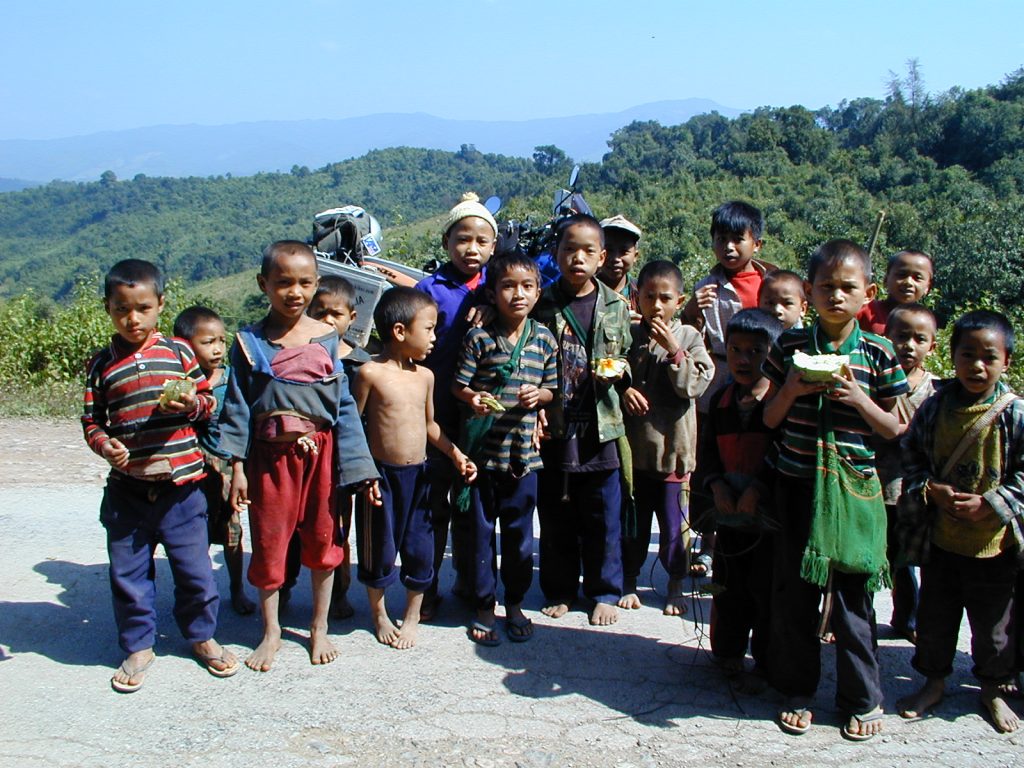
When I stopped to take the photo of the village above, this group of Children ran several hundred metres to come and see me. I don’t think they have ever seen a big motorcycle before. As I have said before, the thing that really struck me about Laos were the smiles. I think I saw more smiles here than the rest of the trip put together. Riding through the hundreds of small villages that dot the road, almost everyone gave me huge smiles and waved.
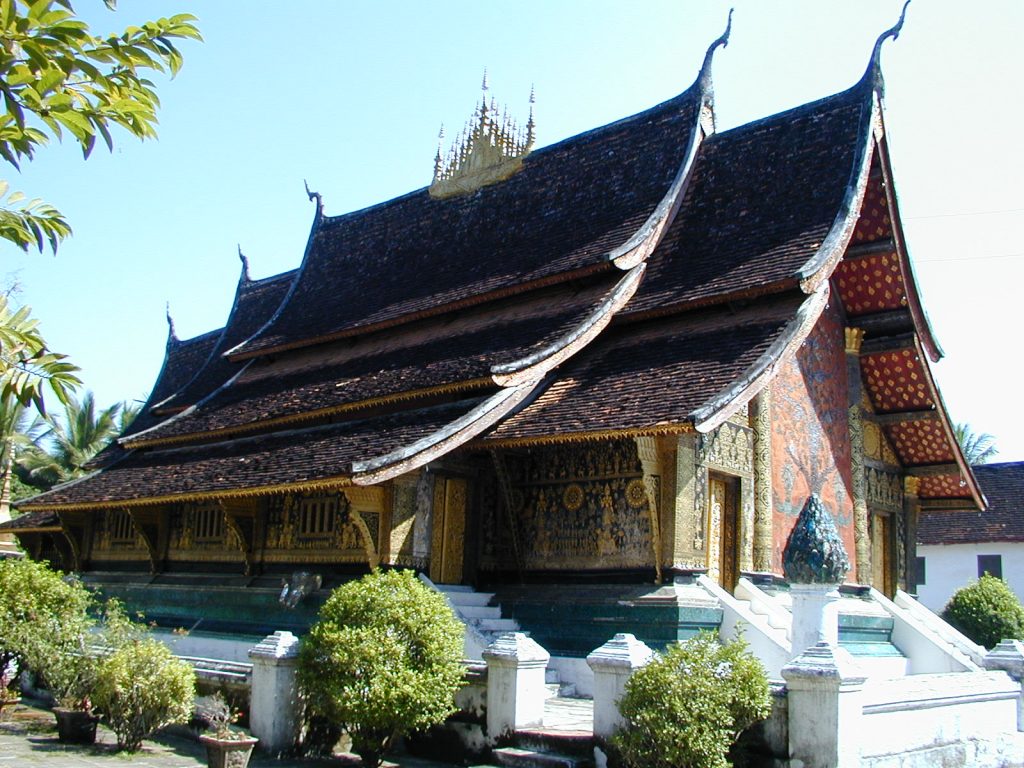
The Royal city of Luang Prabang. The city, population 16,000 is full of beautiful Buddhist temples. The region was a Monarchy until it was removed by the communists in 1975, and to this day, the fate of the royal family is not known.
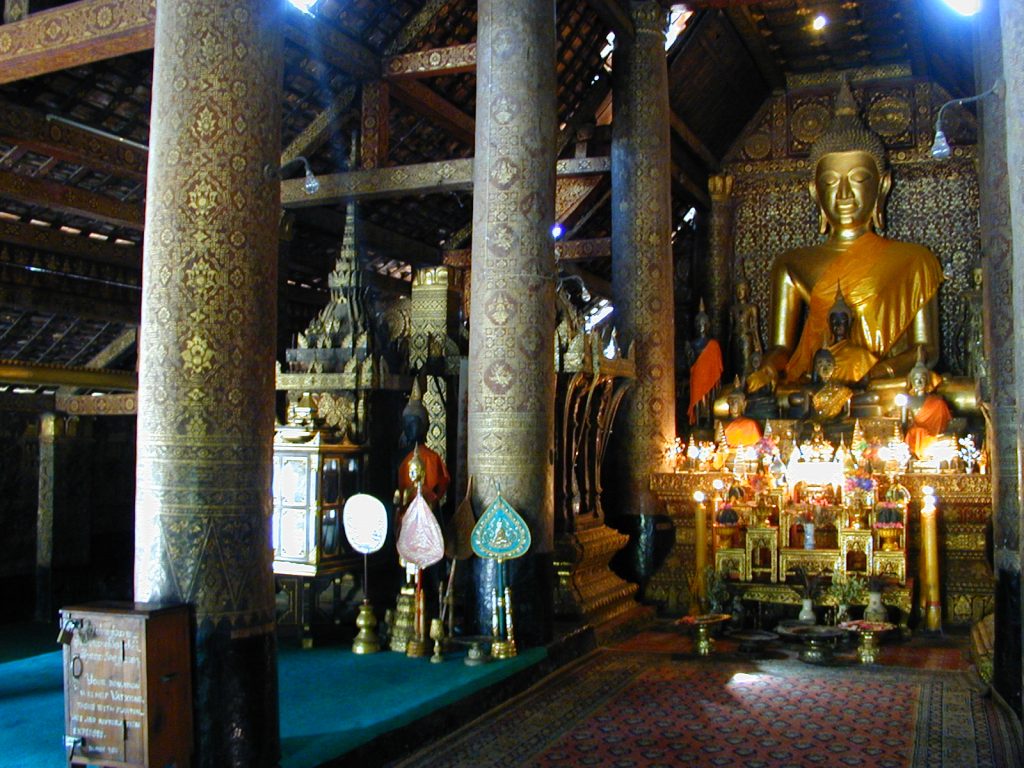
The Buddhist temples are similar, yet subtlety different from those in Thailand.
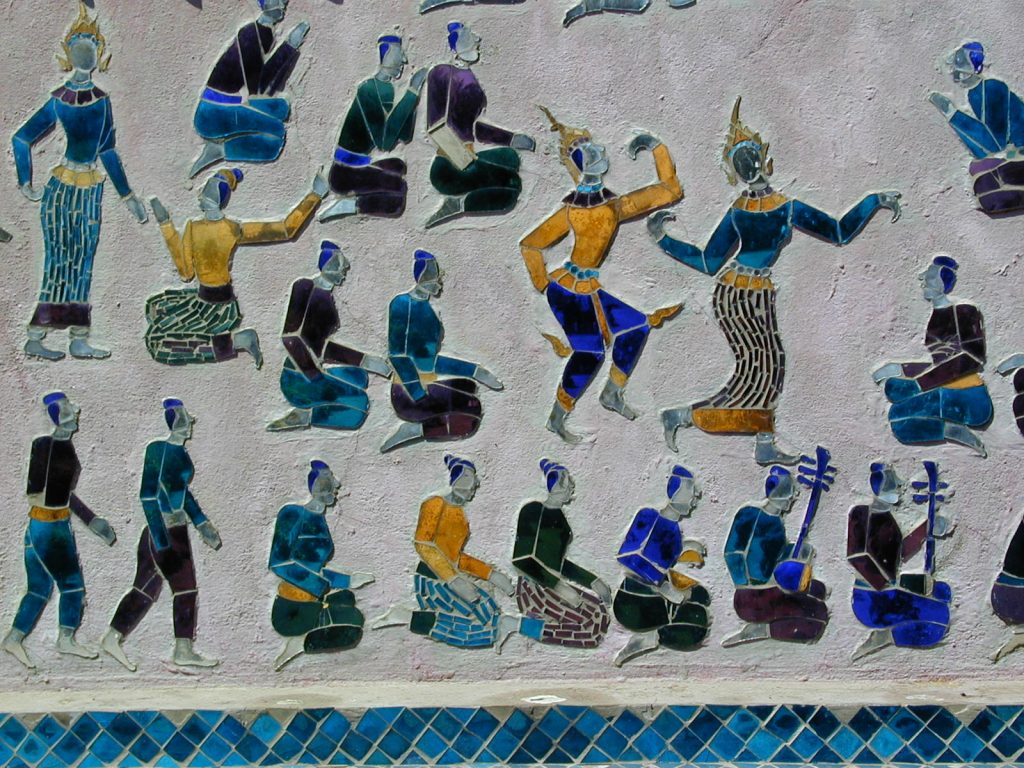
Mirrors glass mosaics on the outside of a temple.
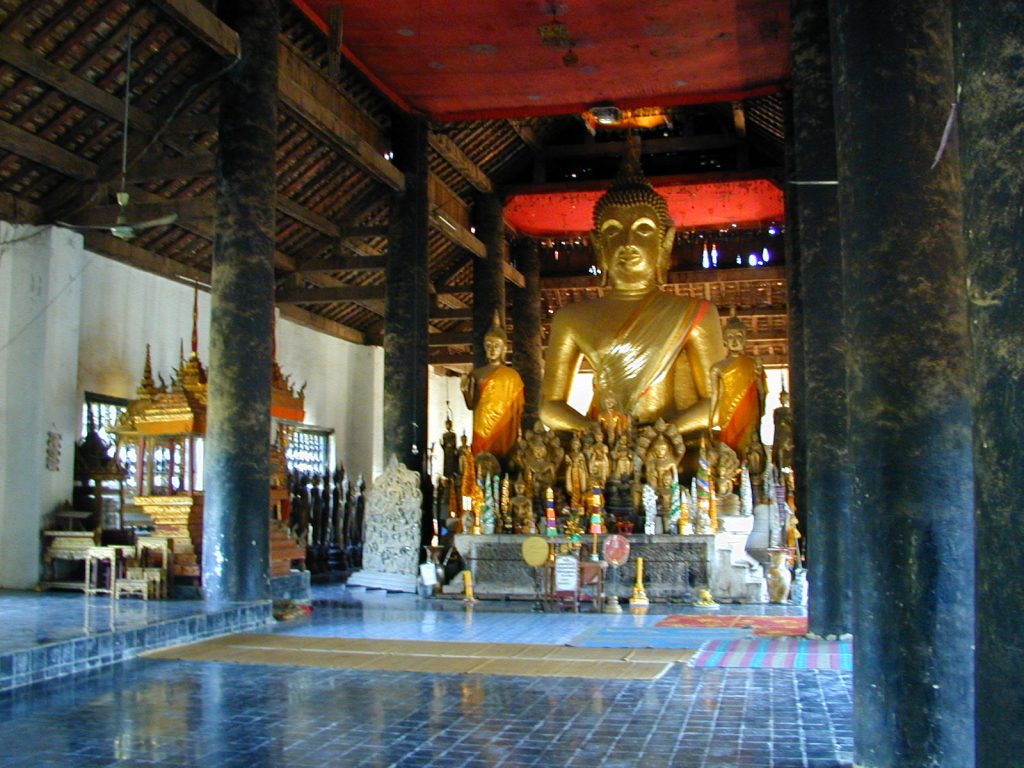
Yet another temple. All the Buddhas are gilded in real gold, or in some cases are solid gold.

Buddhist monk on the top of the hill at the site of the Wat Paa Huak. As in Thailand, ‘Wat’ means temple.
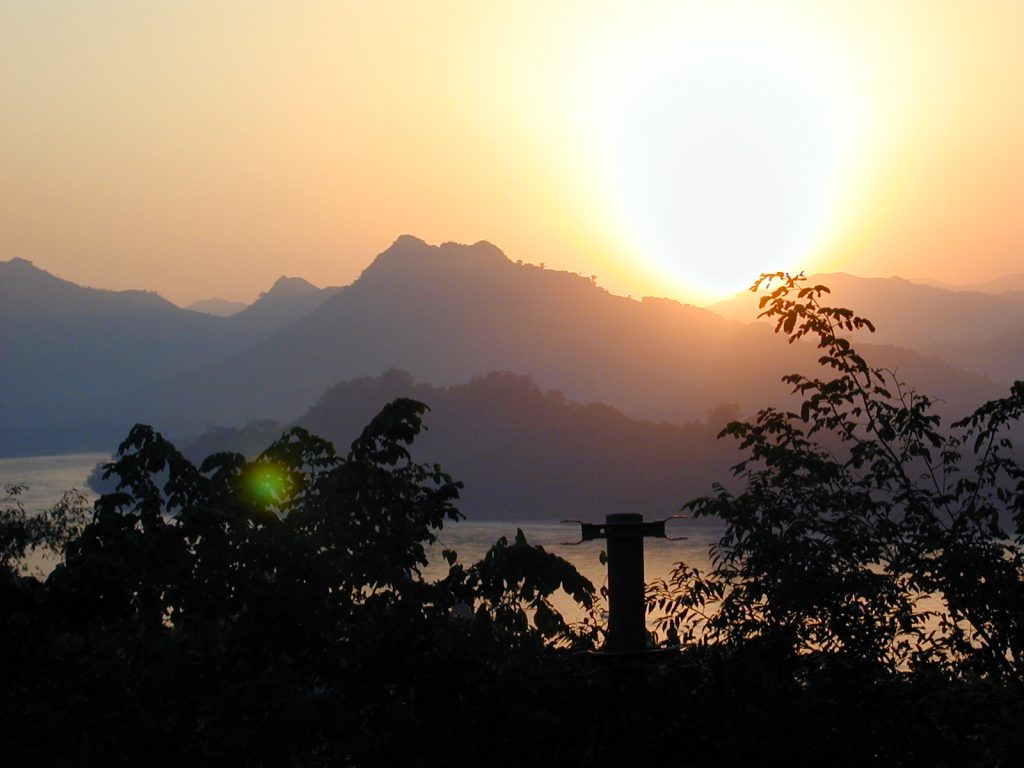
From the Wat Paa Huak, you get to see great sunsets across the Mekong river, such as this.

Everywhere you travel in South East Asia, you get to see sights like this. In this case chillies drying, but also nutmeg, cinnamon, pepper and other spices, as well as all forms of grain such as rice and corn. The colours are spectacular.
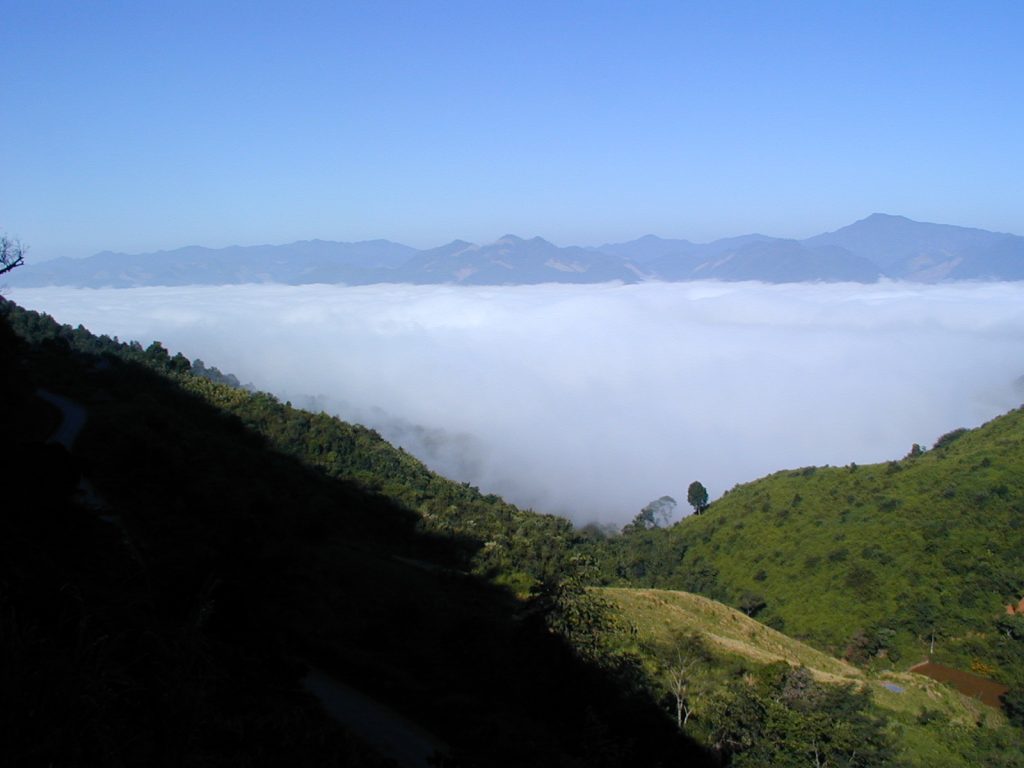
Riding down from Luang Prabang , I headed for Vang Vieng, then onto Vientiane, the capital of Laos. This turned out to be one of the best rides and views I have ever had. When I left early in the morning, I was in the clouds. It was cool enough to wear my heavy jacket. Some time later, I emerged from the clouds to take this shot. Above the clouds, the direct sunlight and crystal clear air made it instantly quite hot. The road was a real blast. Probably the only good road in Laos. It was all mountains, great corners with good visibility…..perfect conditions for having fun!

Ang Nam Ngum, A pretty lake to the north of Vientiane.

In Vientiane, there was a festival on at the time where long boat teams from all over the country come to compete in races. It is similar to outrigger races held in Hawaii and Australia, except that they don’t have outriggers 🙂 There are both men’s and women’s teams. A coxswain at the back steers and calls the strokes. The races went all day for several days, and long into the evenings. I spent a few evenings having a beer, watching the racing, …..and fending off mosquitoes.

At first sight, from a distance, the Patuxai looks like an Arc de Triumph, but when you get closer, you notice the Lao temple like ornamentation. It was built to commemorate Lao lives lost in previous battles, and was built with American cement donated to build a new airport! There are stairs to the top where you can look over the city, but Ididn’t bother. Vientiane is not a very attractive city in my opinion. It certainly is not as interesting as the rest of Laos.
Here I meet up with Cuan again, who had finally repaired his Honda after spending 6 weeks in Bangkok. We went off to the Vietnam embassy to get our visas, then Cuan went north, and I went south. We would meet again to enter Vietnam. I was really looking forward to that country more than any other in SE Asia.
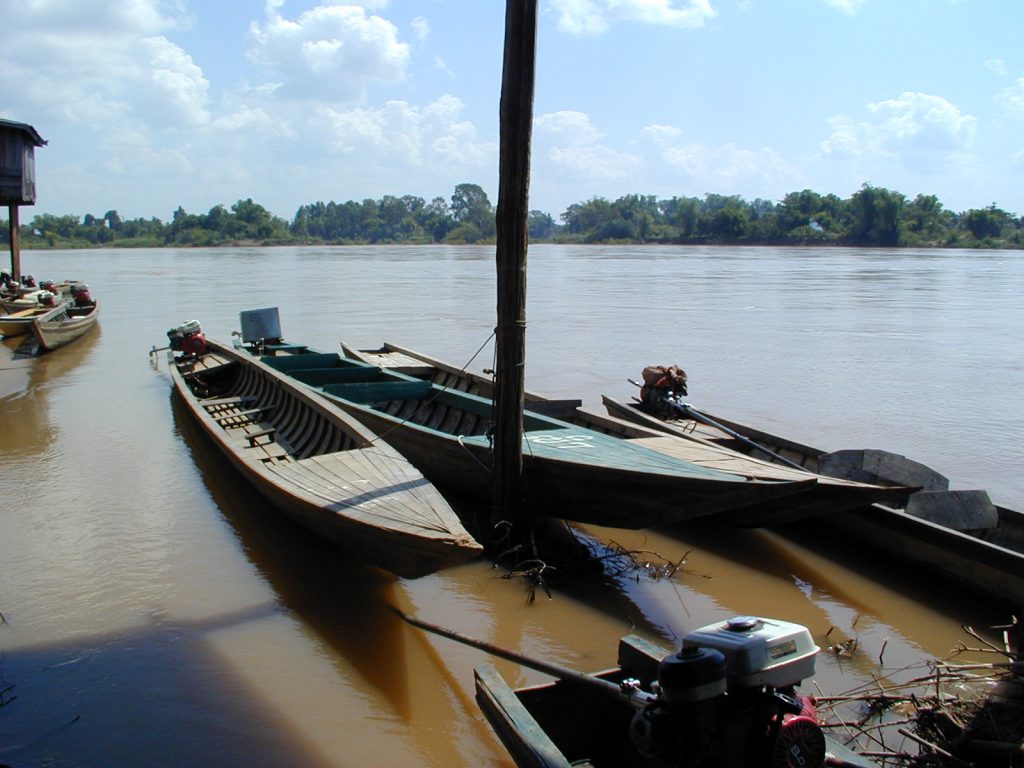
Southern Laos, Si Phan Don (4,000 islands) river archipelago. The Mekong river spreads out to 14 kilometres wide in the wet season, and winds it way through hundreds of islands, or thousands if you count all the sand bars. There are fresh water dolphins here, but I didn’t get to see any. I tried to get across to Don Det island, but this was the only means of transport. These boats are about 600mm, or 2 feet wide, yet the boat owners assured me they could get my bike across. My bike is over a metre tall, just to the tank! It would defy the laws of physics to get it over without taking a dive.
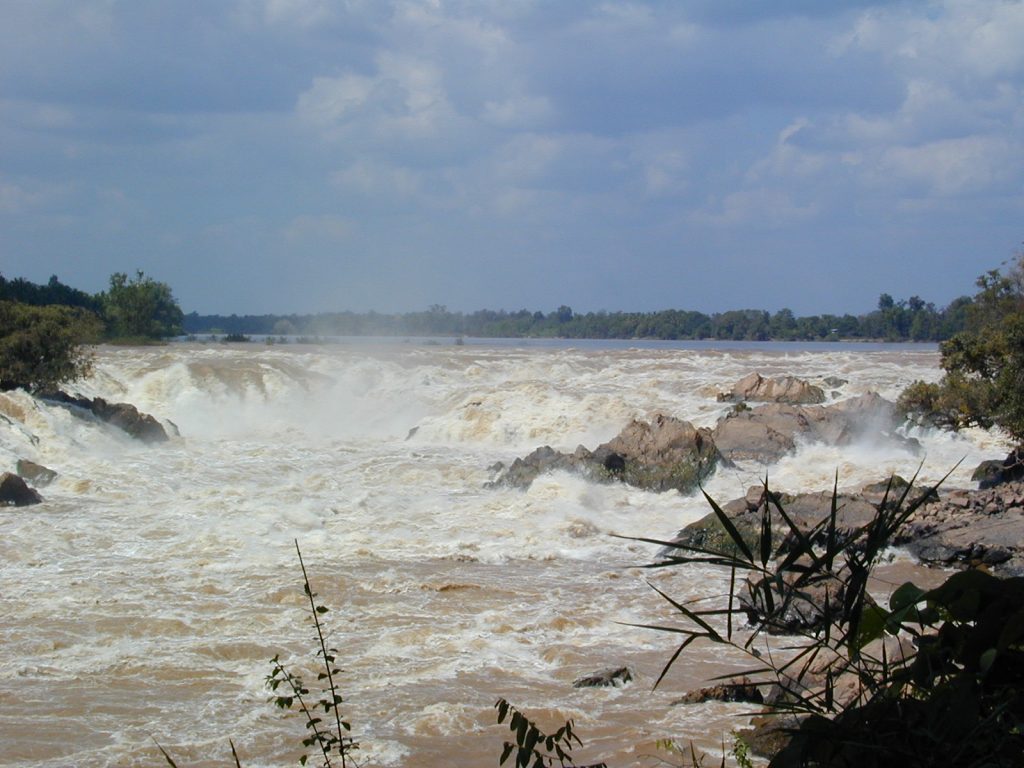
A little further south, there is a 13 klm stretch of powerful rapids where the river narrows again back to just a few hundred metres wide.
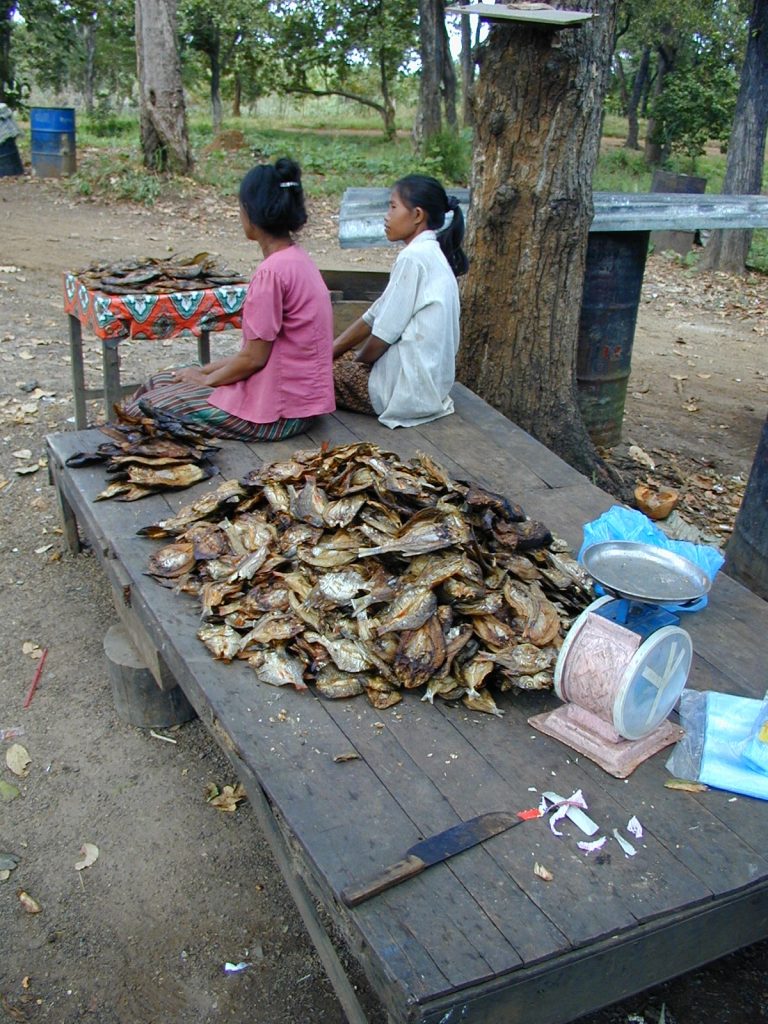
At the rapids, there were lots of local restaurants, where fresh Mekong fish is served. I enjoyed a great fish lunch for about $1. The photo shows a pile of dried fish from sellers in front of the restaurants. Locals snack on them. They don’t prepare it in any way, they just take bites, and chew, bones and all. I wasn’t tempted to try it.
From here, it is only about 13km to the Cambodian border, but it is not open to foreign tourists yet. There is some talk that it will open soon, and that will be a great thing, because getting to the main attraction in Cambodia, Angkor Watt, can be a real pain from Thailand.
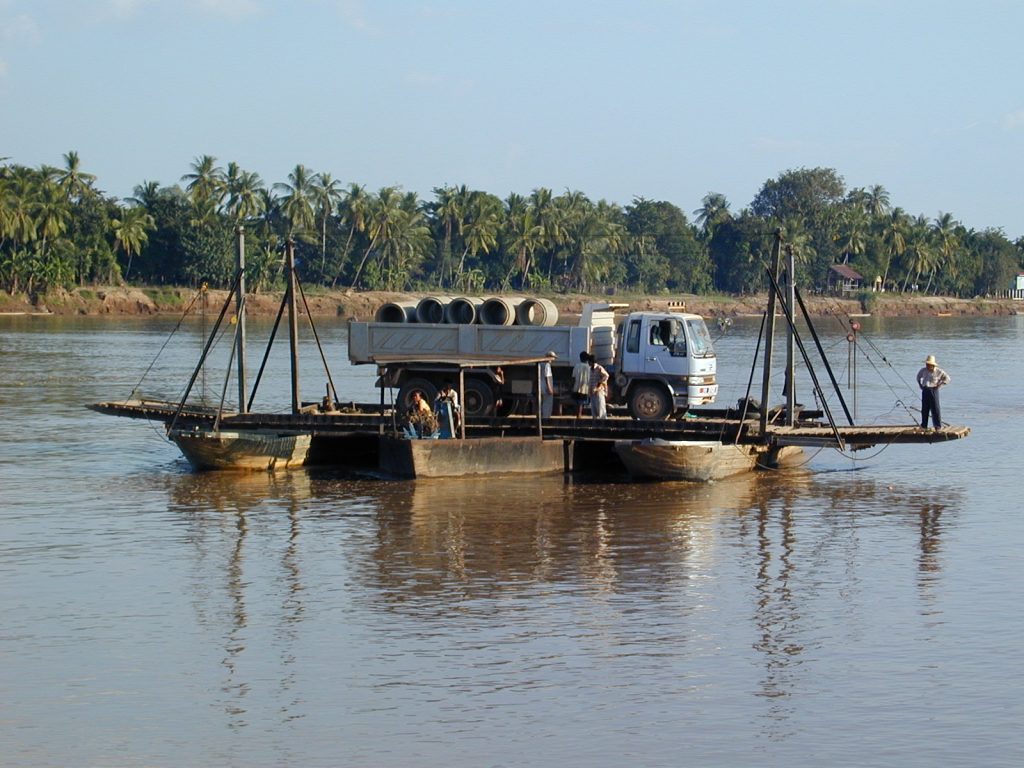
I finally did get across to an island called Don Khong on this interesting barge. It is actually three boat hulls strapped together.

The road to Lao Bao, Vietnam border. Virtually the whole road is like this. Huge ‘potholes’ for most of the distance. It takes trucks 24 hours to do 250km from Savannakhet to Lao Bao, and about 70km of that is good road. They crawl along in first gear for most of the trip.
I was heading for Lao Bao to meet Cuan, where we planned to enter Vietnam. I was staying at a place called Pakse, in the south of Laos, and emailed Cuan to meet me at Lao Bao. Both my map, which I bought in Laos, and my GPS showed a ‘highway’ from Pakse to Lao Bao, a mere 200klm away. This road gradually became a goat track, then finally I came to a halt at a river with no bridge, and no road on the other side. I ended up having to ride 700klm of mostly dirt, and rough dirt at that to get to Lao Bao. The road can only be described as shocking, in both senses of the word. There were no opportunities for rest. I was standing, jumping, and zig-zagging all the way, but it was fun until the sun went down, and I didn’t have anywhere to stay. I had to plug along, riding through black holes in the ground, and got more than a few frights. Some holes were really severe, and I nearly launched myself over the bars on at least two occasions. If you have been reading my stories, you will know how I feel about riding at night. I wasn’t overly worried here, because it was dirt (softer than tar), and relatively low speeds. Since I thought I only had 200klm to do for the whole trip, I told Cuan I should be there by midday, and I was keen to get there because Cuan wouldn’t have any idea what happened to me. Anyhow, after about two hours of night riding, I was relieved to find a guest house, and I gave up trying to make Lao Bao that day.
The next day, I only had another hour or two to make Lao Bao, and found Cuan, or in fact, he found me. So, off we went for Vietnam……
Next day
Go to Vietnam

